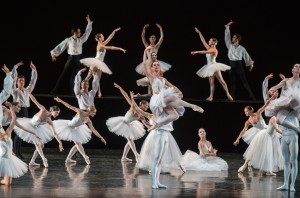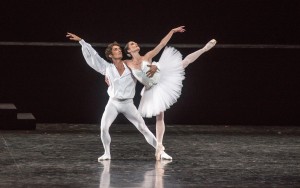By Juliet Neidish
New York City dancegoers just about devoured tickets to see the Paris Opera Ballet’s twelve-day run this summer (July 11-22, 2012). After a nearly sixteen-year absence from New York, Lincoln Center Festival should be commended for presenting this legendary ballet company in three versatile programs. The Paris Opera Ballet dates back to the 17th century and the court of Louis XIV, and it is known and loved for its stellar productions of Romantic and late nineteenth century Classical ballet. But, with the directorship of Rudolf Nureyev in 1983, the Company also began to commission and maintain new, contemporary works, which it has continued to do through the near 20-year reign of current director, Brigitte Lefèvre. To underscore the wide range of its repertory, on view this summer was a program of all-French masters from the 20th-century with works by Serge Lifar, Roland Petit and Maurice Béjart, a full-scale production of Giselle, the quintessence of Romantic ballets, and the U.S. premiere of the evening-length production of Gluck’s, Orpheus and Eurydice, a dance-opera restaged for the company by German choreographer, Pina Bausch in 2005.
Judging by the swift and early ticket sales, there was a great deal of interest in the work of Pina Bausch, the prolific and ground breaking choreographer credited with the development of the genre now referred to as “tanztheater”. Pina has been in our hearts and minds a great deal of late. She passed away suddenly in 2009, at the age of 68. And the memory of the luxurious 3-D film, Pina (2010) by Wim Wenders — an homage to her life’s work with her company, Tanztheater Wuppertal — premiered earlier this year and has hardly faded from memory. In honor of Bausch, the Lincoln Center Festival chose Orpheus and Eurydice as the centerpiece of the Paris Opera programming, highlighting its presentation of this work in print and on the airwaves.
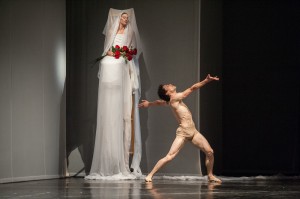
It is unique in itself to see a Bausch work set on a company other than her own. Her work has always been crafted, developed and meticulously honed on her own tightly-knit, though large, group of performers, many of whom have worked together for decades. Since her early creations in Wuppertal in the 1970’s, Bausch enjoyed a close relationship with France (and Italy), where her work was acclaimed by the 1980’s even while in the face of early criticism at home. After reviving its 1975 production of Orpheus and Eurydice in 1991, Tanztheater Wuppertal was invited to perform it in 1993 at the Palais Garnier, the home of the Paris Opera Ballet. Bausch stated that she found the French dancers to be hungry for her work and eventually decided to set her piece on the Paris Opera Ballet. Although most of Bausch’s early dancers were first and foremost trained in ballet, and she continued to bring in ballet masters to give company class, her way of moving dancers on stage does not dwell in the category particular to the technique or style of classical ballet. What the two companies have in common is that despite their different movement genres they both work in exclusively homogenous environments. Unlike most ballet companies today, the Paris Opera Ballet dancers almost all come directly from the strict and specific training of the Paris Opera style that they’ve been reared in at the Paris Opera School, or in some cases by licensed Paris Opera technique teachers in conservatories throughout France. The Tanztheater Wuppertal has had the support to allow them an almost commune-like living/working setting in Wuppertal. Both companies have used government subsidy to create their own highly recognizable signature way of moving. Another important factor supporting their success in working together is the high bar each company has been able to set in their staging of theater spectacle. The Paris Opera Ballet is the national company of France and has long made its reputation on the grandness of its production values. Bausch’s works almost always take place in elaborate physical “environments” whose production values are equally, if differently, spectacular.
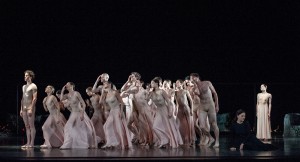
Orpheus and Eurydice is a dance-opera, which runs two hours. It requires an orchestral ensemble, choir, and soloists (The Balthasar-Neumann Ensemble und Chor) and large groups of male and female dancers. Set, costume and lighting designer Rolf Borzik, envisioned the four scenes– Mourning, Violence, Peace, Death — as an exquisite conceptual world encompassing diverse allusions to religious painting, earthworks, contemporary furniture, post-modern mixings, and even bareness. This is a world for dancers and the three vocal soloists (the orchestra and choir remain in the orchestra pit). Everything from bouquets of dried roses, thin string dividing and crossing the stage, hugely tall wooden chairs piled in a corner, a full-size tree laying on its side, roots exposed, feels strange and beautiful, even death. Each scene develops a mood inherent to the mythological story as infused with allegory. In this way, Borzik’s scenography complements Bausch’s dramaturgy. Bausch chooses to tell this story through three dancer and three singer soloists who intermingle and shadow one another, effectively doubling the three main roles: Love/Orpheus, Death/Eurydice, and Youth/Love. The piece resides in a tremendously satisfying balance of dance and opera.
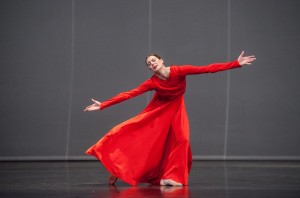
Remarkably, the singers and dancers blend aesthetically and harmoniously, a rarity within today’s clear divisions between the training and staging of dance and opera. Despite the ancient story and early music, (Christoph Willibald Gluck premiered his opera in Vienna in 1762), the overall visual aesthetic is clean, linear and sparse. Scene IV: Death, takes place in a near empty space whose rectangular feel suggests a coffin or crypt. In this scene, only four bodies appear- two singers and two dancers. Orpheus is sung by Maria Riccarda Wesseling and danced by Nicolas Paul. Euyrdice is sung by Yun Jung Choi and danced by Alice Renavand. At first the two singers sing only to each other, and the two dancers dance only to each other, while Orpheus tries desperately to fulfill the intimacy of their journey without ever looking directly at Eurydice, as the story dictates. Soon the singers and dancers acknowledge one another as their bodies begin to cross pathways but when Orpheus can no longer avoid the pleas of Eurydice and proffers the fateful glance, it is then that dancers and singers meld as the body of the dead dancer Eurydice is carefully draped over the body of the dead singer Eurydice now wedded finally, in death.
In this production (July 21, 2012), I found the powerful expressivity of the Gluck to be most reliably communicated by the female corps of dancers. Their ensemble work was mesmerizing in its sheer mass of beautiful, elongated women flowing and pulsating sinuously in Bauschian movement, which accentuates the length of arms and legs. Their long, brown silky dresses often looking sheer under the stage lights, paralleled the naked torso of Orpheus. And in “Dance of the Furies” (Scene II), the angularity and explosiveness of the group choreography which included both male and female bodies, traversed the stage in thrilling frenzy. Eurydice (Renavand) was garbed in striking white and later in blood red. Her overall physicality was long and extended- sometimes still, sometimes coursing, yet at times, she left the Bauschian flow for an interlude of patently innocent flirtatiousness. In those cases, she seemingly reverted to something out of stylistic character as her way to drive the narrative. (Based on a video viewing, I was drawn more to the Eurydice performed by Marie-Agnes Gillot, who danced the role in its Paris Opera inception and also performed in this festival on July 20th & 22.) Mr. Paul, as Orpheus, worked himself quite hard, really pushing to fill the stage, especially when he danced alone. His body was strong and aesthetic and his shapes were complete, but his choice to work with force and crisp tension that reverberated inwardly didn’t allow for the raw, pained expressiveness that is more synonymous with Bausch’s theater and her performers. Within the context of operatic tragedy, arresting ensemble work, and the emotional rendition of the music, these two dance soloists often missed their chance to cause goose bumps. On the other hand, the singer soloists present on stage, could always be relied upon as expressive vehicles. Nevertheless, the brilliant crafting of the whole production, the hard to forget visual grandiosity of the sets, the electrifying musical interpretation, beauty and glamour of the dancers, costumes and lighting, created a powerful and memorable unique experiential journey of the senses.
